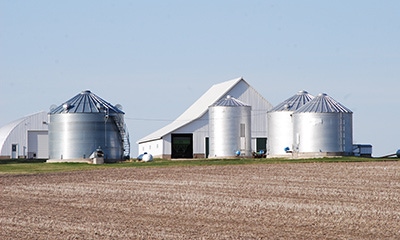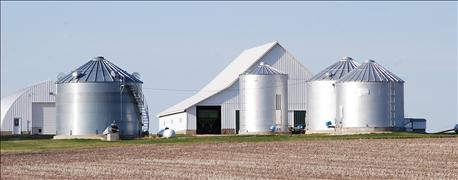February 18, 2016

This year, corn and soybean prices are at historic lows and producers have seen significant declines over the last two to three marketing years. Likewise, because of the uncertainties in the commodity markets, fewer producers have been able to contract their commodities at harvest. I’m considering marketing my stored grain by using a USDA marketing loan. Please explain how they work and what is available.
Editor’s Note: John Whitaker, state director of USDA’s Farm Service Agency in Iowa, answers the following commonly asked questions about FSA’s marketing tools: Nonrecourse Marketing Assistance Loans (MALs) and Loan Deficiency Payments (LDPs).

NEW TOOL: In early February, USDA announced that farmers who have crops pledged as collateral for a marketing assistance loan can now purchase a commodity certificate that may be exchanged for the outstanding loan collateral.
Question: What is a Nonrecourse Marketing Assistance Loan?
Answer: MALs and LDPs are marketing tools available to producers beginning at harvest or shearing. The MAL provides interim financing at harvesttime for producers to meet cash flow needs without having to sell their commodities when market prices are typically at harvesttime lows, allowing the producer to delay the sale of the commodity until more favorable market conditions emerge.
MALs for commodities are considered nonrecourse as the MAL can either be redeemed by repayment or by delivering the pledged collateral to the Commodity Credit Corporation (CCC) as full payment for the MAL at maturity.
Question: What is a Loan Deficiency Payment (LDP)?
Answer: When market prices fall below loan prices, producers can opt to forgo the MAL and can receive LDPs equal to the difference between the local loan price and the lower posted county price (or adjusted world price or national posted price). The availability of LDPs reduces the amount of commodities placed under loan when prices are low.
Question: What commodities are eligible for MALs and LDPs?
Answer: For the 2014 through 2018 crop years wheat, corn, grain sorghum, barley, oats, upland cotton, extra-long staple cotton, long grain rice, medium grain rice, soybeans, other oilseeds (including sunflower seed, rapeseed, canola, safflower, flaxseed, mustard seed, crambe and sesame seed), dry peas, lentils, small chickpeas, large chickpeas, graded and nongraded wool, mohair, unshorn pelts, honey and peanuts are considered eligible commodities.
~~~PAGE_BREAK_HERE~~~
Question: When are MALs and LDPs available?
Answer: Producers may obtain MALs or receive LDPs on all or part of their eligible production anytime during the loan availability period. The loan availability period runs from when the commodity is normally harvested (or sheared for wool) until specified dates in the following calendar year. Producers should contact their local FSA office as soon as possible to discuss crop-specific availability dates.
Question: What are the MAL eligibility criteria?
Answer: To be eligible for a MAL or LDP, producers must comply with conservation and wetland protection requirements and submit an acreage report to account for all cropland on all farms. Additionally, they must have and retain beneficial interest in the commodity until the MAL is repaid or the Commodity Credit Corporation takes title to the commodity while also meeting Adjusted Gross Income (AGI) limitations.
In addition to producer eligibility, the commodity must have been produced, mechanically harvested, or shorn from live animals by an eligible producer and be in storable condition. It also must be merchantable for food, feed or other uses, as determined by CCC. Nonrecourse MALs must meet specific CCC minimum grade and quality standards.
Question: What are the current MAL loan rates?
Answer: The 2014 Farm Bill sets national loan rates. County and regional loan rates are based on each commodity’s national loan rate, and they vary by county or region and are based on the average prices and production of the county or region where the commodity is stored.
Question: What is a Commodity Exchange Certificate and how does it relate to marketing assistance loans and loan deficiency payments?
Answer: Certificates are a loan repayment option -- the same as repaying with cash. The commodity certificate option only applies when a market gain is in effect for a commodity.
Commodity certificates do not change how producers contract their commodities and do not change the beneficial interest rules for obtaining a CCC marketing assistance loan. USDA sells generic (generic refers to the fact the certificate is not commodity specific) commodity certificates to producers seeking to repay outstanding marketing loans for less than the loan price.
The producer buys a certificate at the posted county price (or adjusted world price or national posted price) for the quantity of commodity under loan, immediately exchanges it for the collateral, and thus pays off the loan. In December 2015 Congress enacted the Consolidated Appropriations Act of 2016, which directed USDA to make commodity certificates available to producers.
Question: What are Market Loan Gains (MLGs) and how are payment limitations impacted by MLGs related to commodity certificates and LDPs?
Answer: Under the CCC nonrecourse marketing assistance loan program, the repayment amount for a loan secured by the pledge of an eligible commodity is generally based on the lower of the loan rate or the prevailing world market price for the commodity on the date of repayment. If the loan is repaid when the world price is lower, the difference between that lower repayment amount and the original loan amount is market gain.
If using commodity certificates to repay the loan, the benefit is not counted against the payment limitation on Market Loan Gains (MLGs). LDPs offer similar income benefits to marketing loan gains but they apply against the payment limitation.
Landowners and producers interested in learning more about marketing assistance loans, loan deficiency payments and related programs should visit fsa.usda.gov or contact your local FSA office. A list of offices is at offices.usda.gov.
You May Also Like




